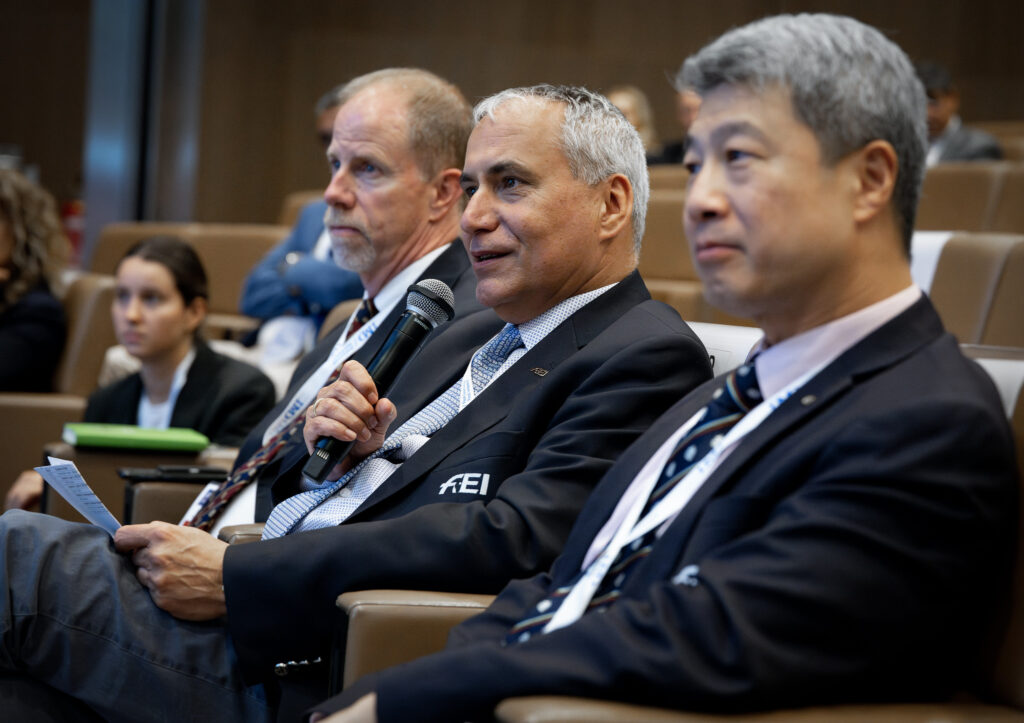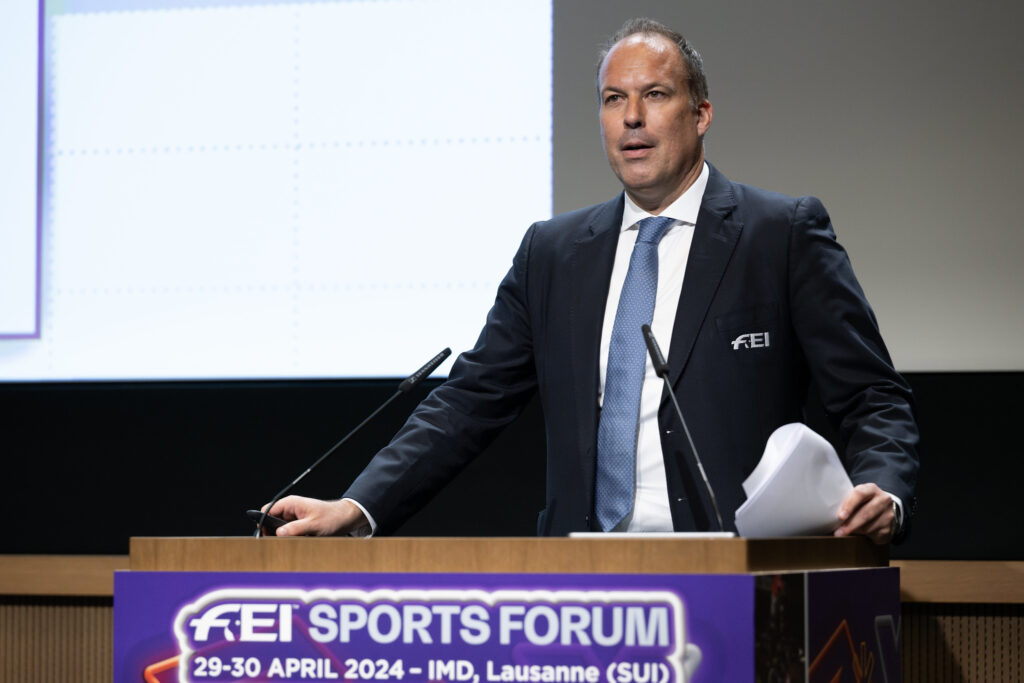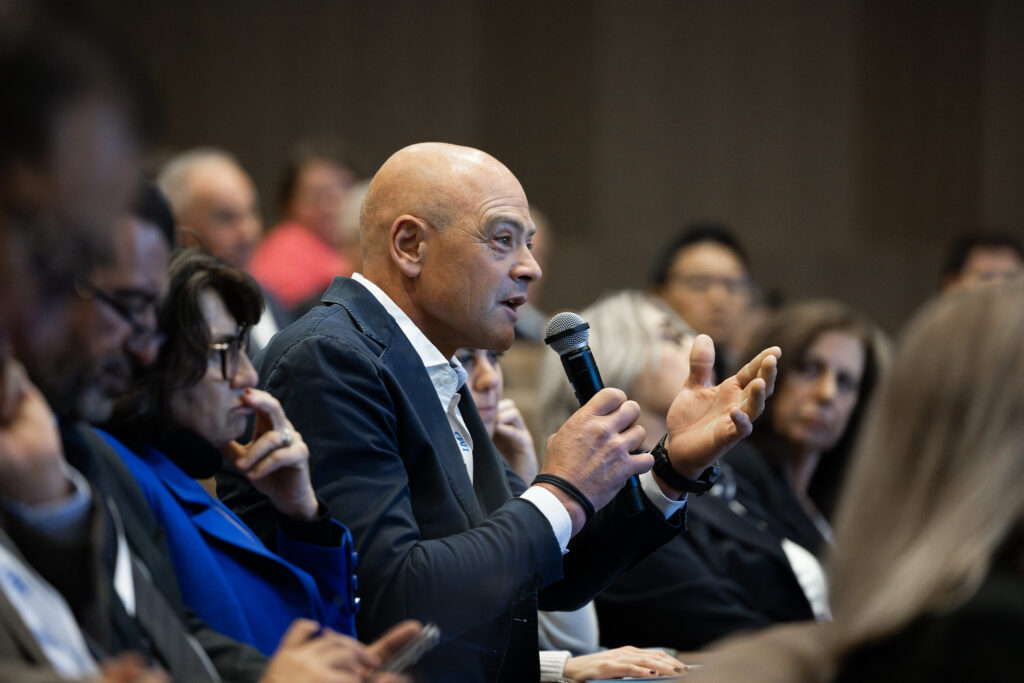Session 1: Equine Ethics and Wellbeing Commission final report and proposed action plan
Monday, 29 April, 9:30 – 12:30, IMD, Lausanne
FEI president Ingemar de Vos gave a welcome speech to an almost full auditorium at the IMD in Lausanne. As expected, he declared his contentment over the League of Nations’ first legs and underlined that Paris preparations were well underway.
When it came to the subject of the day, the much-awaited report and action plan following the Equine Ethics and Wellbeing Commission final report and proposed action plan he declared that the time-table for “The Good Life for horses” will run into November 2024 and the rollout will continue with all NF:s.
Mr de Vos then changed tune completely stating:
“Don’t write to me about your concerns, think about what you can do yourself on your level. We started our process early in 2022, we are on our way, help where you are instead of writing to me.”

The first Session of the FEI Sports Forum 2024 was dedicated to the final report produced by the independent Equine Ethics and Wellbeing Commission and the proposed action plan developed by the FEI Headquarters based on the recommendations outlined in the report.
In her introduction, session moderator FEI Secretary General Sabrina Ibáñez reminded delegates of the reasons for the Commission’s creation, its composition, and the timeline it had followed. She thanked the Commission for its valuable work and introduced the session panelists, FEI Veterinary Director Göran Åkerström and FEI Legal Director Mikael Rentsch. The Secretary-General highlighted the responsibility of the entire community for preserving and enhancing horse welfare.

The full report has been available online at least for a few days ahead of the Sports forum, it is a 51-page document, a bit abstract “to-do-list” for the FEI requiring extensive work in many areas, existing work fields, and quite new areas. To read the full report, you find it here. The report describes an approach but when it comes down to what needs to be done in practical terms – it is all in the hands of the FEI.
FEI Welfare Strategy
The Report outlined 30 recommendations – six of those presented at an early stage in the Commission’s work – which had been divided into six priority areas of focus – training and riding, tack and equipment; recognizing physical and emotional stress; accountability, enforcement, and knowledge; the other 23 hours (the life of horses outside of competition); competitive drive; not fit to compete (masking health problems). Once combined, the early recommendations, the Final Report recommendations, and priority areas of focus generated 62 action points. And, none of them are tiny tasks either, this is the Sisyfos project for the FEI, a neverending ongoing process, in constant need of evaluation and re-evaluation.
The Commission had further outlined a suggested approach urging the FEI to be a Leader; be Trusted; be Transparent; be Proactive; and be Accountable, and had proposed tools for action.

This approach informed the FEI Welfare Strategy, the initial stage of which was presented at the session, based on a Welfare Vision for a good life for horses, and a Welfare Mission, with the FEI serving as the guardians of FEI horses by formulating and implementing rules, guidelines, educational programs and other initiatives. Where required, the FEI applies sanctions to ensure good horse welfare with the overall mission to lead, drive, and develop equestrian sport globally.
“We no longer talk about horses as our partners. We are their guardians”, stated Göran Åkerström

Tools
An essential tool for action to deliver this Welfare Strategy is the Five Domain model, which was updated in 2020 to achieve and measure horse welfare through nutrition, physical environment, health and fitness, and interactions with the environment, with other horses, and with humans. A positive mental state equals good welfare.

Action plan
Swedish ethology and animal science expert Malin Axel-Nilsson was due to be a panelist in the session but was unable to attend. However, she had already assisted FEI Headquarters with entering the 62 action points into a matrix listing the actions already put in place by FEI, possible future actions, ways for the FEI to support and collaborate with the National Federations and other official stakeholder groups, and had linked it to the relevant domain of animal welfare.

Göran Åkerström and Mikael Rentsch presented the main elements of this matrix and provided details for many of the key proposed actions, including a broader approach to reviewing tack and equipment; resuming scientific research on hyperflexion and rollkur; and developing guidelines, principles, rules, and possibly registration of trainers across the disciplines to ensure ethical training methods. Other key projects discussed in detail were the development of harmonized post-mortem reporting protocols in national events with the support of the NFs; updating the FEI Code of Conduct for the Welfare of the Horse in collaboration with World Horse Welfare; strengthening the awareness and use of the FEI Equestrian Charter, and the implementation of an Out of Competition Testing Programme.
The FEI Equestrian Charter is a pledge to care for the horse that all involved parties will take and honor. FEI wants to see the NFs implement the charter on a national level, a document the athletes and other stakeholders have to confirm and sign yearly.
Glimpses from the presentation
From the presentation the following fragments can be worth mentioning, have a look at the whole presentation here.
FEI will develop guidelines/principles/rules/registration to ensure ethical training methods and they will resume the scientific work on “hyperflexion” and “rollkur” to address the complexity. As Göran Åkerström pointed out after some discussion in the auditorium;
“We mustn’t in any way look away from that there are issues that need to be addressed. When the older studies were conducted the science was a bit different. Equine behavioral science has come into the equation within the last 5-10 years and that makes the old studies outdated.”
One of the action points aim to establish an oral cavity control protocol to be used at FEI events. The first part of this work is done in Denmark.
A recent study shows that a double bridle can significantly reduce rein tension for some riders and the issue is complex.
There is a continuous discussion on non-mandatory double-bridle in dressage and the FEI is considering implementing an extensive tack list for all disciplines, not just dressage as of today.
Noseband, as voted at the GA in 2023 a new noseband rule will be in place as of 1 January 2025. Development of an FEI Objective Measuring tool is underway, the recommendation is to do measuring ahead of the competition to avoid harm and bad pictures. A protocol for check is under development and the measuring tool will be available for anyone to buy and use.
How to handle Article 142 – Abuse of the horse. The good news is that anyone can report “abuse of horse”. If it is a FEI registered horse, the FEI has jurisdiction even if the abuse happens in a stable. There is not a limitation time to when it is too late to act.
As a part of this process, FEI reviews all older yellow cards to see if there is a cause to open proceedings if the offense should require sanctions or consequences.
Discussions
All through during the session the auditorium posed questions or made comments. Voices from the dressage community were distressed and asked for support. Profiles such as Michael Klimke and Mariette Withages spoke up as well as Kjell Myhre and Diana el Shaer. The common ground was that they required action from the FEI and felt the discussion had tilted the wrong way.
As Diana el Shaer stated:
“Dressage riders are under attack.”
An unexpected advocate for the use of the double-bridle was jumping rider Francois Mathy JR, chairman of IJRC.
“The discussion about double-bridle feels alien. We need to be able to use precision tools. You need to involve the riders in the discussion. A loose noseband is described as bad but when my horse put the tongue over the bit it is worse for him”. [applause from the auditorium]

Swedish veterinary delegate Peter Kallings was active in the discussion and advocated for stricter medication rules for FEI stating that many other horse organizations have less tolerance for medication and stated the FEI has a more lenient approach to allowing antibiotics during competition.
“We propose that antibiotics should not be allowed during competition. Antibiotics have a pain-killing effect and can indirectly work to mask other reasons for the horse to be not fit to compete.”
Jessica Stark from World Horse Welfare made a valid point after the presentations went into Q&A sessions.
“Where is the voice of the horse in all this work and where comes the actual welfare?”
Feedback
The work accomplished by the FEI to date was commended by delegates, many of whom expressed valuable suggestions such as Swedish Secretary General Johan Fyrberg. The importance of education, information, and communication was highlighted on several occasions. The need to consult closely with athletes, trainers, and Officials was also raised, and there were calls to celebrate examples of good horse welfare from both Jessica Kürten and Kjell Myhre. Several NF representatives such as Jason Brautigam, British Dressage, shared positive experiences of implementing the Equestrian Charter in their national rules.
Eleonora Ottaviani from the IJRC shared a positive development in Italy in relation to the welfare of the horse.
“The Italian federation did a good job with the Italian government. The horse is now, since last year, regarded equal to a human and receives the same protection legally. In case of abuse, the horse has the same rights as a human.”
The FEI Secretary General emphasized that the FEI Welfare Vision and Mission would inform all FEI activities going forward. She urged participants to consult the presentation used during the session, urging Sports Forum participants and the community to provide their feedback by 15 May to an email especially created for this purpose welfare@fei.org.
This will be used as part of developing a detailed action plan to be presented at this year’s FEI General Assembly.
